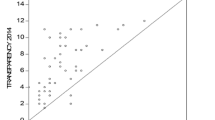Abstract
This paper explores why rating agencies disagree on a country’s sovereign default risk. Specifically, we analyse the sovereign ratings of four agencies and their interactions on an empirical basis. Our findings indicate that the frequency of split ratings and their lopsidedness are the result of uncertainty and the use of different rating methodologies but not of a home bias. Still, rating agencies treat world regions differently. Finally, a small and subscriber-paid agency appears to be more independent but also more volatile in its rating behaviour than the issuer-paid Big Three (Standard and Poor’s, Moody’s and Fitch).

Similar content being viewed by others
Notes
See Handelsblatt (January 17, 2012): “The myth of the U.S. conspiracy”.
The authors find that the Big Three exhibit only a weak home bias. Only S&P is shown to rate the USA better than other countries and Fitch exhibits a home bias for both France and the USA (based on ownership and headquarter).
Only a limited number of the Big Three ratings are unsolicited (26.6% in this sample). We find no significant difference across rating agencies between unsolicited and solicited ratings for one particular country. The results are available on request.
Some of those studies find that the relationship is bi-directional.
Investors do not necessarily rely on the rules of this standardized approach if they use the internal risk-based approach (IRB).
The authors find that the certification of a new CRA (DBRS) was followed by rating upgrades from the Big Three for those firms which received higher ratings by DBRS after certification.
A country list is provided in “Appendix”.
More details are provided in “Appendix” of this paper.
For instance, S&P’s may be more hesitant to push a country to junk status (BBB- to BB+) than to assign a downgrade within the range of investment-grade ratings.
Logit estimation results are available from the author on request.
Besides the emerging market economies, this applies also to a number of industrialized countries, namely Greece, Israel, Portugal, South Korea and the Eastern European countries.
For instance, Fitch Ratings describe political risk as “the risk that the sovereign authorities will lack the political capacity and will to mobilize resources necessary to honour their financial obligations” (Fitch 2014). The other agencies provide similar concepts ( Moody’s (2013), Standard and Poor’s (2013)).
Positive values are set equal to zero.
The home bias has not been identified for Feri and Moody’s and it is shown to hold for Fitch in France and the USA at the same time (ownership and headquarter).
We compare the ratings of each Big Three agency only with its large competitors and not with Feri in order to be able to apply the full rating scale.
Feri produces only unsolicited ratings and the Big Three also have a share of 10–20% unsolicited ratings across all country groups and regions.
References
Abad P, Alsakka R, ap Gwilym O (2018) The influence of rating levels and rating convergence on the spillover effects of sovereign credit actions. J Int Money Finance 85:40–57
Adelino M, Ferreira MA (2016) Bank ratings and lending supply: evidence from sovereign downgrades. Rev Financ Stud 29(7):1709–1746
Afonso A, Gomes P, Rother P (2011) Short and long run determinants of sovereign debt credit ratings. Int J Finance Econ 16(1):1–15
Afonso A, Furceri D, Gomes P (2012) Sovereign credit ratings and financial markets linkages: application to European data. J Int Money Finance 31(3):606–638
Alsakka R, ap Gwilym O (2010) Leads and lags in sovereign credit ratings. J Bank Finance 34(11):2614–2626
Arezki R, Candelon B, Sy A (2011) Sovereign rating news and financial markets spillovers: evidence from the European debt crisis. In: IMF working papers, 11/68:1–27
Bhattacharya U, Wei KD, Xia H (2014) Follow the money: investor trading around investor-paid rating changes. In: Working paper presented at the 2014 NBER credit rating agency meeting
Borensztein E, Cowan K, Valenzuela P (2013) Sovereign ceilings ”lite”? The impact of sovereign ratings on corporate ratings. J Bank Finance 37(11):4014–4024
Bruno V, Cornaggia J, Cornaggia KJ (2015) Does regulatory certification affect the information content of credit ratings? Manage Sci 62(6):1578–1597
Cantor R, Packer F (1996) Determinants and impact of sovereign credit ratings. Econ Policy Rev, pp 37–53
Cruces JJ, Trebesch C (2013) Sovereign defaults: the price of haircuts. Am Econ J Macroecon 5(3):85–117
Ferri G, Liu L-G, Stiglitz JE (1999) The procyclical role of rating agencies: evidence from the east asian crisis. Econ Notes 28:335–355
Fitch R (2014) Sovereign rating criteria. www.fitchratings.com
Fuchs A, Gehring K (2017) The home bias in sovereign ratings. J Eur Econ Assoc 15(6):1386–1423
Gaertner M, Griesbach B, Jung F (2011) Pigs or lambs? The european sovereign debt crisis and the role of rating agencies. Int Adv Econ Res 17(3):288–299
Gttler A, Wahrenburg M (2007) The adjustment of credit ratings in advance of defaults. J Bank Finance 31(3):751–767
Hill P, Faff R (2010) The market impact of relative agency activity in the sovereign ratings market. J Bus Finance Account 37(9–10):1309–1347
Kaufmann D, Kraay A, Mastruzzi M (2010) The worldwide governance indicators: methodology and analytical issues. In: The world bank policy research working paper, vol WP5430, pp 1–29
Kisgen DJ, Strahan PE (2010) Do regulations based on credit ratings affect a firm’s cost of capital? Rev Financ Stud 23:4324–4347
Livingston M, Naranjo A, Zhou L (2007) Asset opaqueness and split bond ratings. Financ Manage 36(3):49–62
Moody’s (2013) Rating methodology: sovereign bond ratings. www.moodys.com
Morgan DP (2002) Rating banks: risk and uncertainty in an opaque industry. Am Econ Rev 92(4):874–888
Opp CC, Opp MM, Harris M (2013) Rating agencies in the face of regulation. J Financ Econ 108(1):46–61
Standard and Poor’s (2013) Sovereigns: sovereign government rating methodology and assumptions. www.standardandpoors.com
Author information
Authors and Affiliations
Corresponding author
Appendix
Appendix
See Tables 13, 14, 15, 16, 17, 18, 19 and 20.
Rights and permissions
About this article
Cite this article
Bartels, B. Why rating agencies disagree on sovereign ratings. Empir Econ 57, 1677–1703 (2019). https://doi.org/10.1007/s00181-018-1503-y
Received:
Accepted:
Published:
Issue Date:
DOI: https://doi.org/10.1007/s00181-018-1503-y




